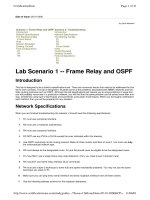Chapter 11 :Asynchronous Transfer Mode and Frame Relay docx
Bạn đang xem bản rút gọn của tài liệu. Xem và tải ngay bản đầy đủ của tài liệu tại đây (427.6 KB, 62 trang )
William Stallings
Data and Computer
Communications
Chapter 11
Asynchronous Transfer Mode
and Frame Relay
Protocol Architecture
❚
Similarities between ATM and packet switching
❙
Transfer of data in discrete chunks
❙
Multiple logical connections over single physical
interface
❚
In ATM flow on each logical connection is in
fixed sized packets called cells
❚
Minimal error and flow control
❙
Reduced overhead
❚
Data rates (physical layer) 25.6Mbps to
622.08Mbps
Protocol Architecture (diag)
Reference Model Planes
❚
User plane
❙
Provides for user information transfer
❚
Control plane
❙
Call and connection control
❚
Management plane
❙
Plane management
❘
whole system functions
❙
Layer management
❘
Resources and parameters in protocol entities
ATM Logical Connections
❚
Virtual channel connections (VCC)
❚
Analogous to virtual circuit in X.25
❚
Basic unit of switching
❚
Between two end users
❚
Full duplex
❚
Fixed size cells
❚
Data, user-network exchange (control) and network-
network exchange (network management and routing)
❚
Virtual path connection (VPC)
❙
Bundle of VCC with same end points
ATM Connection Relationships
Advantages of Virtual Paths
❚
Simplified network architecture
❚
Increased network performance and reliability
❚
Reduced processing
❚
Short connection setup time
❚
Enhanced network services
Call
Establishment
Using VPs
Virtual Channel Connection
Uses
❚
Between end users
❙
End to end user data
❙
Control signals
❙
VPC provides overall capacity
❘
VCC organization done by users
❚
Between end user and network
❙
Control signaling
❚
Between network entities
❙
Network traffic management
❙
Routing
VP/VC Characteristics
❚
Quality of service
❚
Switched and semi-permanent channel
connections
❚
Call sequence integrity
❚
Traffic parameter negotiation and usage
monitoring
❚
VPC only
❙
Virtual channel identifier restriction within VPC
Control Signaling - VCC
❚
Done on separate connection
❚
Semi-permanent VCC
❚
Meta-signaling channel
❙
Used as permanent control signal channel
❚
User to network signaling virtual channel
❙
For control signaling
❙
Used to set up VCCs to carry user data
❚
User to user signaling virtual channel
❙
Within pre-established VPC
❙
Used by two end users without network intervention to
establish and release user to user VCC
Control Signaling - VPC
❚
Semi-permanent
❚
Customer controlled
❚
Network controlled
ATM Cells
❚
Fixed size
❚
5 octet header
❚
48 octet information field
❚
Small cells reduce queuing delay for high priority
cells
❚
Small cells can be switched more efficiently
❚
Easier to implement switching of small cells in
hardware
ATM Cell Format
Header Format
❚
Generic flow control
❙
Only at user to network interface
❙
Controls flow only at this point
❚
Virtual path identifier
❚
Virtual channel identifier
❚
Payload type
❙
e.g. user info or network management
❚
Cell loss priority
❚
Header error control
Generic Flow Control (GFC)
❚
Control traffic flow at user to network interface (UNI)
to alleviate short term overload
❚
Two sets of procedures
❙
Uncontrolled transmission
❙
Controlled transmission
❚
Every connection either subject to flow control or not
❚
Subject to flow control
❙
May be one group (A) default
❙
May be two groups (A and B)
❚
Flow control is from subscriber to network
❙
Controlled by network side
Single Group of Connections (1)
❚
Terminal equipment (TE) initializes two variables
❙
TRANSMIT flag to 1
❙
GO_CNTR (credit counter) to 0
❚
If TRANSMIT=1 cells on uncontrolled connection
may be sent any time
❚
If TRANSMIT=0 no cells may be sent (on
controlled or uncontrolled connections)
❚
If HALT received, TRANSMIT set to 0 and
remains until NO_HALT
Single Group of Connections (2)
❚
If TRANSMIT=1 and no cell to transmit on any
uncontrolled connection:
❙
If GO_CNTR>0, TE may send cell on controlled
connection
❘
Cell marked as being on controlled connection
❘
GO_CNTR decremented
❙
If GO_CNTR=0, TE may not send on controlled
connection
❚
TE sets GO_CNTR to GO_VALUE upon receiving
SET signal
❙
Null signal has no effect
Use of HALT
❚
To limit effective data rate on ATM
❚
Should be cyclic
❚
To reduce data rate by half, HALT issued to be
in effect 50% of time
❚
Done on regular pattern over lifetime of
connection
Two Queue Model
❚
Two counters
❙
GO_CNTR_A, GO_VALUE_A,GO_CNTR_B,
GO_VALUE_B
Header Error Control
❚
8 bit error control field
❚
Calculated on remaining 32 bits of header
❚
Allows some error correction
HEC Operation at Receiver
Effect of
Error in
Cell Header
Impact of Random Bit Errors
Transmission of ATM Cells
❚
622.08Mbps
❚
155.52Mbps
❚
51.84Mbps
❚
25.6Mbps
❚
Cell Based physical layer
❚
SDH based physical layer









